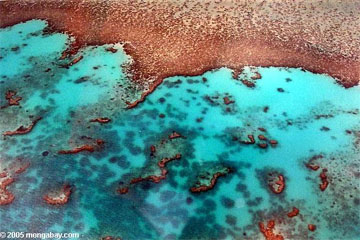Coral susceptibility to bleaching due to small differences in symbiotic relationship
Coral susceptibility to bleaching due to small differences in symbiotic relationship
Jeremy Hance, mongabay.com
July 22, 2008
|
|
Coral reefs are now considered the second most threatened group of animals in the world, with nearly one-third of corals listed as endangered (amphibians retain the dubious honor of being number one). Although corals face many threats, the greatest is bleaching caused by warming oceans due to climate change. However, some coral populations are more susceptible to bleaching than others, even including corals of the same species. New research has uncovered that the reason lies in small differences in the symbiotic relationship between corals and their symbionts, small marine animals and protozoa. Such differences, however minuscule, have a huge impact on the likelihood of a coral’s ability to survive warming oceans.

|
When a coral reef undergoes extreme stress—such as rising temperature—they may lose their symbionts, leading to the bleaching and eventual death of the coral. To get a clearer picture of this relationship, researchers studied forty-six populations of the coral species S. pistillata, which had a symbiotic relationship with the genus Symbiodinium. Despite studying the same coral species facing the same environmental changes, the scientists found that some populations of coral died or were significantly damaged through bleaching while others remained healthy.
The discrepancy lay in slight differences among the coral’s symbionts. Studying the plankton at the subclade level—subclade is a definition describing a group within a subgenus—the scientists found clear distinctions of a coral susceptibility to bleaching. Four groups emerged, identified by the subclades of Symbiodinium. Two of the groups suffered complete bleaching and high mortality rates, while the other two groups remained healthy. In addition, the different subclades of plankton showed similar responses in the coral’s ability to recover from bleaching effects. The researchers suggest that future studies take subclade distinctions into account when estimating the susceptibility of coral to climate change:

|
Research published over the past year indicates that PETM climate change helped drive the evolution of modern primates by causing the dispersal of tarsier-like primates across the globe.
“During the past 500,000 years coral communities have shown incredible persistence in taxonomic composition and diversity”, the authors write, noting that it is only in the past three decades that coral populations have plunged, coinciding with climate change and increasing human-induced stressors. Knowing which corals possess a better chance of survival grants conservationists and policy-makers more means to mitigate the damage to this embattled group of animals.
“Predictions of an increased frequency and severity of bleaching events in the coming decades will significantly impact tropical near-shore communities. It is therefore imperative that we fully understand the mechanisms driving coral community change,” the authors conclude.
Eugenia Sampayo, Tyrone Ridgway, Pim Bongaerts, and Ove Hoegh-Guldberg (2008). Bleaching susceptibility and mortality of corals is determined by fine-scale differences in symbiont type. PNAS July 25, 2008